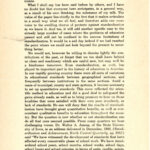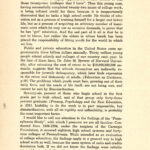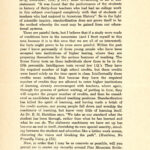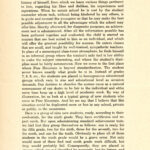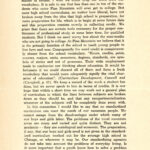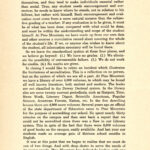Pine Mountain Settlement School
Series 07: DIRECTORS
Glyn Morris
Talks
Upper Cumberland Educational Association
Oct. 8, [no year, possibly c. 1937]
Beyond Accreditation

Morris, Glyn. “Beyond Accreditation.” [01 morris_glyn_1935_UCEA_talk_001.jpg]
GLYN MORRIS Talks UCEA Beyond Accreditation
c. 1935
TAGS: Glyn Morris, Beyond Accreditation, Upper Cumberland Educational Association (UCEA), Union College, protests against standardization, educational standards, quantitative standards, PMSS Board of Trustees, standardized public schools, PMSS students, PMSS educational philosophy, letters to parents vs report cards, students’ cumulative record sheet, limitations of accreditation, PMSS library, credit system
TRANSCRIPTION: Beyond Accreditation
01
Text of Talk, Delivered before the Upper Cumberland Educational Association, at a meeting held on October 8th, [1935] in the Chapel at Union College, Barbourville, Kentucky.
BEYOND ACCREDITATION
When Doctor Gross asked me last summer to speak on the subject “Beyond Accreditation” I was delighted to do so. I believe he asked me to do this because of what Pine Mountain Settlement School has done, and is now in the process of doing, towards freeing itself from the burden of standardization– standardization to the detriment of the task at hand, which is that of educating, in the broadest sense, mountain boys and girls. I should explain here that I use the terms accreditation and standardization as synonymous, although I believe that technically accreditation is the end to which standardization is the means.
What I shall say has been said before by others, and I have no doubt but that everyone here anticipates, in a general way, as a result of his own thinking, the substance of my talk. The value of the paper lies chiefly in the fact that it makes articulate in a small way what we all feel, and therefore adds one more voice to the swelling chorus of protests against standardization as we know it. And too, it will add another specific case to the already large number of cases where the problems of education cannot and will not be confined to the narrow limitations of standardization. It would be a sad day indeed if we had reached the point where we could not look beyond the present to something better.
We would not, however, be willing to dismiss lightly the contributions of the past, or forget that we too shall leave behind us ideas and machinery which are useful now, but may well be a hindrance tomorrow. Even standardization, as such, has played its important part in the history of education in America. In our rapidly growing country there were all sorts of variations in educational standards between geographical sections, and frequently between institutions in the same sections. Amid a maze of municipal, county and state systems, it became necessary to set up quantitative standards. This move reflected the scientific method in education and did a good deal to safeguard the gains already made, as well as to bring pressure to bear on those localities that were satisfied with their own poor standards, or lack of standards. No one will deny that the results of standardization have brought great quantitative benefits, as well as concomitant qualitative benefits to education throughout the country. But the question is now whether or not standardization can do all that once seemed possible. From many quarters we hear challenging voices. Dr. Walter A. Jessup, of the State University of Iowa, in an address delivered in December 1932, (Standardization and Achievement, North Central Quarterly, pp. 2659) said “We have witnessed the development of standards that have affected every conceivable phase of school work. We have standardized school years, school months, school weeks, school days, school hours and school minutes, in terms of units, credits, points, majors. At the rate we have been going in recent years, we will soon interpret education in terms of split seconds.”
And we do interpret education that way, and have made youth conscious of education only as the process of obtaining so many units as the result of putting in so much time. A short time ago I received a very urgent letter from a former Pine Mountain student in which he claimed there had been an error in the matter of his high school credits. Education was to him pretty much a matter of securing a number of units as quickly as possible–so he migrated from place to place as opportunity presented itself. He couldn’t really be getting an education be-…
02
…cause he did not stay in any one place long enough to feel its spirit. Finally, he went to college, completed his first year in one school, then transferred to another, and now he is beginning his third year, but to his dismay the registrar of the third college had informed him that there is an error in his high school record, and that he is one credit short. And so the young man writes us that he is being refused credit by the present college for the two years he has already spent in another college because he is short one high school credit. He writes, “If I haven’t thirteen, I know that I have twelve and three-fourths. Since I need thirteen credits from Pine Mountain so badly, would you be so kind as to transfer thirteen to * * * * *, and I shall take any kind of test that you want me to. As you know, this means so much to me, and your favor in transferring thirteen credits to * * * * * will be highly appreciated. I hate indeed to lose those twenty-two (college) that I have”. Thus this young man, having successfully completed twenty-two hours of college work, is being refused credit for them because it is inopportunely discovered that he lacks a high school credit. He thinks of education not as a process of training himself for a larger and better life, but as a process of acquiring an arbitrary number of inanimate units which he may use as occasion demands, to prove that he has “got” education. And the sad part of it all is that he is not to blame, but rather the elders in whose hands has been placed the responsibility of fitting youth for the world in which we live.
Public and private education in the United States costs approximately three billion dollars annually. Thirty million young people attend schools and colleges of our country each year. In the face of these facts, Dr. John M. Brewer of Harvard University, after estimating the cost of crime to be $10,000,000,000 annually, suggests that the schools themselves are indirectly responsible for juvenile delinquency, which later finds expression in the crime and dishonesty of adults. (Education as Guidance, p 59) The problems which youth must face, growing out of their daily lives, and the needs of life itself, are not being met, and cannot be met by Standardization.
Seventy-six percent of those who begin school in the first grade get to high school, and of that group only forty-three percent graduate. (Pressey, Psychology and the New Education, p. 336). Inability to do the work is in part responsible, but standardization, with all its rigidity and inflexibility, is probably the most important factor.
I would like to call our attention to the findings of the “Pennsylvania Study”, with which I presume we are all familiar. Conducted from 1928-1934, under the auspices of the Carnegie Foundation, it covered eighteen high school systems and forty-nine colleges of Pennsylvania. While intended as an evaluation of college education, the findings apply in a general way to high school work as well, because the same system of units and credits dominates both. If we did not know the findings were reliable we could scarcely believe them. As a matter of actual fact the result showed that four years in college do a great deal towards un-educating students. Senior[s], in a series of tests given to the entire student bodies of six representative colleges, knew less in some subjects than did the sophomores. And too, the few gains made were so small that they were scarcely justified, considering the time and money spent. Mr. John R. Tunis, who reported some of the findings in Scribners, of September and November 1934, asks “Where does the fault lie? With the students themselves? The teachers? Or the college administration? The study places the blame for the present state of higher education in this country on none of those named; but rather on the so-called credit system, one germane to the colleges and PMSS universities of the United States. This system whereby one takes a certain number of courses and receives a fixed number….
03
…of points for every course passed, automatically entitles one to a degree when the necessary number of points is acquired”. (Scribners, September, 1934. pp. 138-44.)
Dr. Jessup, in the address from which I previously quoted, reported on the results of state-wide examinations conducted by the University of Iowa. “Thus, many schools that have the same external standards of selecting teachers, teaching load, building, and other conditions to meet the North Central Association list, rank actually lower than other schools which are not accredited.” “Indeed,” he says, “an array of ninety-two North Central High Schools and 283 non-accredited high schools distributed for average composite student scores revealed almost complete overlapping. Fourteen percent of the non-accredited schools had an average score which exceeded the average score of all the accredited schools. (North Central Association Quarterly, December, 1932, p 267). Most devastating of all is this statement: “It was found that the performance of the students in history of thirty-four teachers who had had no college work in this subject overlapped completely with that of students of teachers who had majored in American History”. So in the light of scientific inquiry, standardization does not prove itself to be the method whereby the most may be gained from our educational systems.
These are painful facts, but I believe that if a study were made of conditions here in the mountains (and I limit myself to this area because it is in this area that we are all of us interested) the facts might prove to be even more painful. Within the past year I know personally of three young people who have been accepted into institutions of higher learning, where they are preparing themselves for the serious business of teaching. The Sones Harry tests on these individuals show them to be in the fifth percentile. Intelligence tests reveal low I.Q.’s. They have the required number of high school credits, but these credits were based solely on the time spent in class. Intellectually these credits mean nothing. But because they have the required number of credits they are allowed to enter higher institutions of learning, already over-swamped with teachers where, again, through the process of patient waiting, of putting in time, they will acquire the proper number of credits, and then be considered as candidates for school teaching positions. Standardization has killed the spirit of learning, and having made a fetish of the credit system, our young people fall down and worship the machinery of learning, but know very little of learning itself. As Dr. R. M. Hutchins says, “We take as our standard what the student has been through, rather than what he has learned and what he can do. The elaborate machinery we have set up has become an end in itself, cherishing its own special sanctity, standing between the student and education like a latticework screen, obscuring the vision and blocking the path”. (Hutchins, No Friendly Voice, p 175).
Now, in order that I may be as concrete as possible, will you permit me to center my remarks around Pine Mountain Settlement School. It should be said from the first, that Pine Mountain is singularly fortunate. The Board of Trustees is anxious and willing that the school serve in as practical a way as possible, the young people of the mountains. The school has no obligation other than that it serve efficiently and sensibly the youth for whom it was created. The Board of Trustees has welcomed experimentation. Also, while Pine Mountain cannot in any manner be considered wealthy, its set-up allows more expense per capita than our public school system. And furthermore, at Pine Mountain, we have the students twenty-four hours of the day. But against all these advantages we have one drawback which no public school has. Our students attend Pine Mountain PMSS because they want to, and they stay there because they want to.
It is utterly impossible for us to use any form of coercion. Our….
04
…school program must be interesting enough to keep the students there.
With all our advantages it has been possible for us to do some things which have not as yet been done by public school systems, but in this we have come to see ourselves in sharp contrast with standardized public schools, and we see their standardization as a distinct evil. Our students come to us from a standardized system, and we must always remember that if they go from us to any other school they will return to a standardized system. Consequently our attempts at change so far have been carried on against some obstacles.
When a student comes to Pine Mountain he is fairly well known to us through a systematic method of fact-finding. If possible we have visited his home and secured a lengthy record of his home and parents. He too has made out for us a five-page history of himself, from which we learn various things pertinent to him, regarding his likes and dislikes, his experiences, and aspirations. When he enters school he is met by the student counselor whose task, without being hindered by any others, is to guide and counsel the youngster so that he may make the best possible adjustment to all the advantages which the school may offer him. Shortly afterward, for diagnostic purposes, an achievement test is administered. After all the information possible has been gathered together and evaluated, the child is started on courses that are best suited to him as an individual, and which will offer the greatest possibility for success. He enters classes that are small, and taught by well-trained, sympathetic teachers. In place of a stereotyped class-room atmosphere, he finds himself in an informal group where the teacher’s only tool is her ability to make the subject interesting, and where the student’s discipline must be fairly autonomous. Now we come to the first place where Pine Mountain is beyond standardization. The student never knows exactly what grade he is in. Instead of grades 7, 8, 9, etc., the students are placed in homogeneous educational groups which vary in size and educational level as occasion demands. Our decision to abandon the system came as a natural consequence of our desire to be fair to the individual and at the same time keep up a high level of academic work. By way of illustration, let us look at a typical group of new students who come to Pine Mountain. And let me say that I believe that this situation could be duplicated more or less in any school, private or public, in the mountains.
Here is a group of nine new students, ready, according to their credentials, for the ninth grade. They have certificates and report cards. But upon administering standard achievement tests, we find that they group themselves as follows: one is ready for the fifth grade, two for the sixth, three for the seventh, two for the ninth, and one for the tenth. Obviously to place all of these students in the ninth grade would be a grave error. Not only would most of them find real ninth grade work difficult, but they would probably fail. Consequently, they are placed in groups, which are not identified by numerals, but by letters, and which cover enough variation in ability to make it rather difficult for standardization. Then, within this grouping the student is assigned work which is made as individual as possible, and at which he may proceed at his own rate of speed.
Is it any wonder then that our new students find the first few weeks difficult at Pine Mountain? In most cases they soon recognize the spirit of the thing and the response is usually very gratifying. But often they feel as was expressed by one of the girls, in explaining to the Counselor her difficulty at adjustment– “It didn’t seem like school to me”.
Now we come to the second place where Pine Mountain must part with a standardized system. Insofar as possible we are eliminating the possibility of failure. No one is not promoted. First, the student is given work which matches his ability. Our diagnosis permits us to be fairly accurate in the matter of….
05
…placement, so that a child whose achievement test shows fifth-grade level is not placed in the ninth grade to meet continuous difficulty and eventually failure. Furthermore, no work is repeated. If we find that the child cannot do the work, he moves on to something which he can do with some measure of success. This does not mean that all difficult tasks are eliminated and that there are no intellectual hurdles. But it does mean that they are reasonably consistent with the child’s ability. Standardization, with its rigid demand that every individual conform to an intellectual standard, which has no sound basis in real life, has been the cause of many failures, resulting in unnecessary maladjustment. Therefore, with the child as the center of our school, we cannot allow the sort of failure which the child cannot understand.
The third place where we part with standardization is in the matter of credits. I wish we could drop the word from our vocabulary. It is safe to say that less than one in ten of the students who enter Pine Mountain will ever get to college. But most high school curriculums, no matter how liberal, have not broken away from the idea that high school is preparation, for more preparation for life, which is to begin at some future date and this preparation consists merely in collecting credit. We grant that there are certain tools necessary for the proper continuance of professional study at some later time for qualified students. But I think we need worry less about the nine-tenths who are not going to college. At Pine Mountain we believe that it is the primary function of the school to teach young people to live here and now. Consequently the word credit is conspicuously absent from the school vocabulary. “Hours, credits, points, courses, majors, units, semesters, degrees, standards, are symbols of status and not of processes. Their wide employment tends to mechanize our thinking about education. It would be fortunate if we could discard all of them and form a fresh vocabulary that would more adequately signify the vital character of education”. (Curriculum Development, Caswell and (Campbell, p. 60). We keep a record of the work a student has done, but we never speak to him in terms of credits. It is our hope that within a short time we may work out a general plan of curriculum in which the lines between subjects are broken down as they should be, and that any compartmentalization whatever of the subjects will be completely done away with.
In this connection I would like to say that no standardized curriculum can meet the needs of our mountain people. We cannot escape from the disadvantages under which many of our boys and girls labor. The problems of the rural mountain areas are many and varied and quite distinct. They are not academic — they are sociological and economic. The preparation, if any, that our boys and girls need is not given in the standardized curriculum worked out for the average high school in Chicago, or wherever it may be. Our standardizing agencies do not take into account the problems of everyday living. Is it more important that a youth know how to solve a problem in geometry, or that he should know how to build a cheap and comfortable house? Is it more important that a girl know how to understand the square root of a locomotive wheel, or that she know something about the problem which she will face as a mother? These problems are individual, and on the basis of what we can find out about a child, we can predict somewhat his personal need, and to meet these the curriculum requires a flexibility that standardization cannot supply. Only a few weeks ago, one of our doctors remarked that Kentucky had the highest death rate from tuberculosis of all the states in the union. Our schools dole out credits and our people die for lack of knowledge.
The fourth place where we leave standardization is in the…
06
…matter of grades. The only report we send to parents is a letter which goes out at the close of each semester. This letter, however, covers the matter of the student’s whole life at Pine Mountain. Academic work, whatever that may be, is only a part of his life, and therefore it receives only its fair proportion of attention in the report. More important is the matter of the student’s relations with his fellows in the community of which he is a part; his manner of response to the social obligations placed upon him as a citizen of our small society; and all other indications which reflect his growth into a well-rounded individual. We are convinced that grades as we know them are a false incentive for work. We used to send out report cards every six weeks. Three years ago we stopped this. The release of tension has been very noticeable. Grades are unobjective; no two teachers, and no two school systems can mark alike. They have become an end in themselves, and they tend to make individuals unsocial rather than social. True, any student needs encouragement and correction; he needs to know where he stands, not in relation to his fellows, but rather with himself. Such encouragement and evaluation must come from a more natural source than the subjective grading of a teacher. If any evaluation is to be given, it must be of what has been done, compared with what could be done, and must be within the understanding and scope of the student himself. At Pine Mountain we have made up from our own data and other sources a cumulative record sheet covering the whole of the student’s life. If we, or anyone else wishes to know about the student, all information necessary will be found there.
So we leave the standardized system at these four places, and we believe go beyond: (1.) We have no grades. (2.) We eliminate the possibility of unreasonable failure. (3.) We do not work for credits. (4.) No marks are given.
In closing I would like to relate an incident which illustrates the limitations of accreditation. This is a reflection on no person, but on the system of which we are all a part. At Pine Mountain we have a library of over 4,000 volumes, in which may be found all well-known literature, both ancient and modern. The books are not classified to the Dewey Decimal system. In the library also are some twenty current periodicals, such as Harpers, Time, News Week, Literary Digest, Scientific American, Popular Science, American Forests, Nation, etc. In the five dwelling houses there are 4,000 more volumes. Several years ago an official of the state department of Education came to Pine Mountain for the purpose of accrediting our school. He spent nearly thirty minutes on the campus and then sent back a report that we could not be accredited since there was a flaw in our Library system. This in spite of the fact that there were 8,000 volumes of good books on the campus, easily available. And last year our students made an average gain of thirteen school months in English.
It was at this point that we began to realize that we must do one of two things. And with deep desire to serve the needs of its young people, Pine Mountain has definitely broken with any accrediting agencies. We cannot serve two masters. Either we serve the young people for whom the school was intended, giving their personalities every opportunity for expression and growth as individual needs dictate, or we serve an accrediting agency. The first calls for more work, but “education is a hard job and a good deal harder than we may have thought. Since we must admit our present methods are defective we shall have to admit that we should exert what intelligence we have to improve them. The successful installation of such a scheme, or of a better one designed to accomplish the same objectives, will require long and painstaking thought. But thought is what education today requires; and, if we are in education, it is our business to put it forth”. (No Friendly Voice, Hutchins, p. 186).
GALLERY: Beyond Accreditation
October 8, 19??
- 01 morris_glyn_1935_UCEA_talk_001
- 02 morris_glyn_1935_UCEA_talk_002
- 03 morris_glyn_1935_UCEA_talk_003
- 04 morris_glyn_1935_UCEA_talk_004
- 05 morris_glyn_1935_UCEA_talk_005
- 06 morris_glyn_1935_UCEA_talk_006
See Also:
GLYN MORRIS Director
ARTHUR W. DODD 1946 General Statement of History and Philosophy of PMSS for Staff
GLYN MORRIS 1940 General Statement of History and Philosophy of PMSS for Staff
Back To: GLYN MORRIS 1931-1977 Guide to Talks, Writing, and Publications

